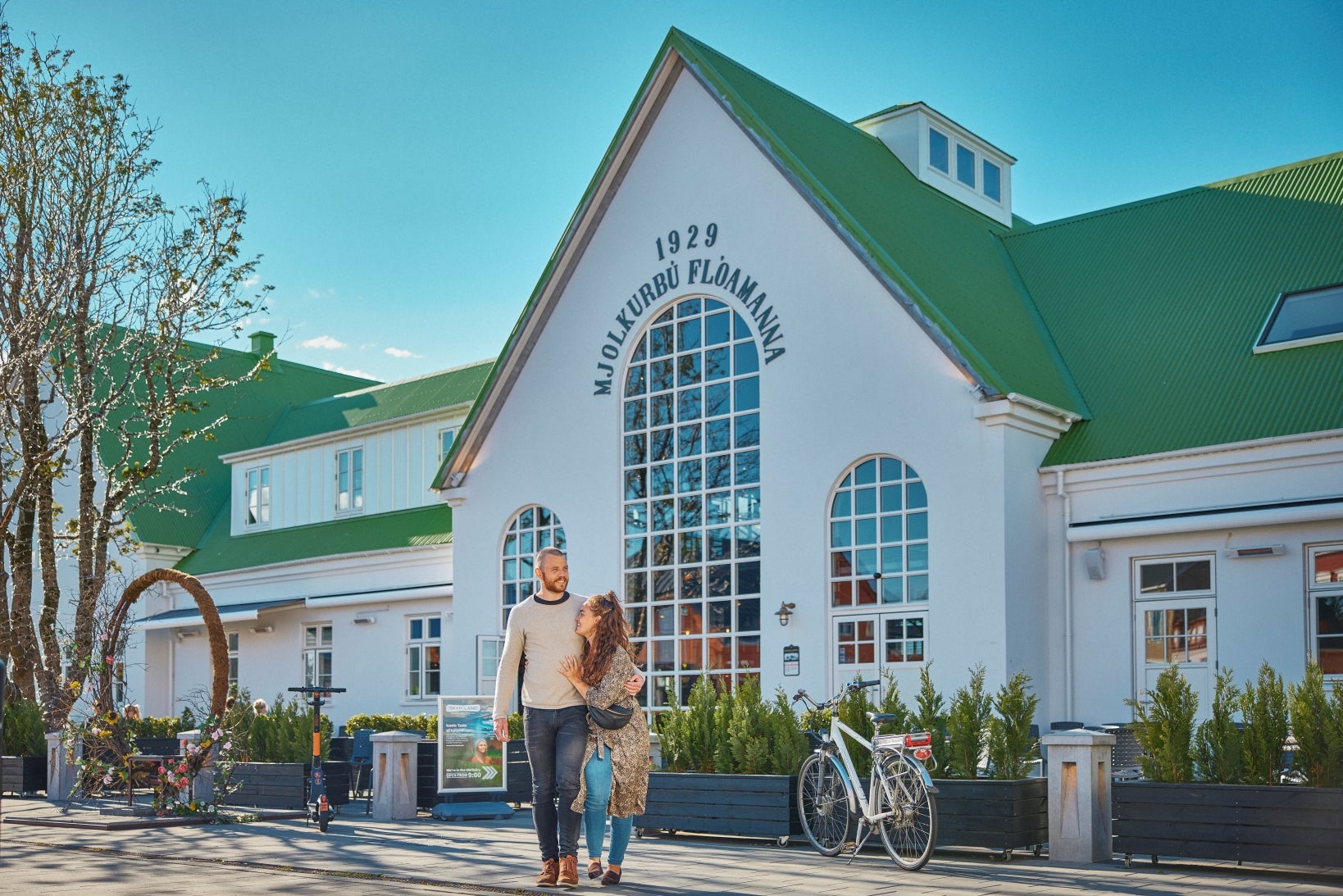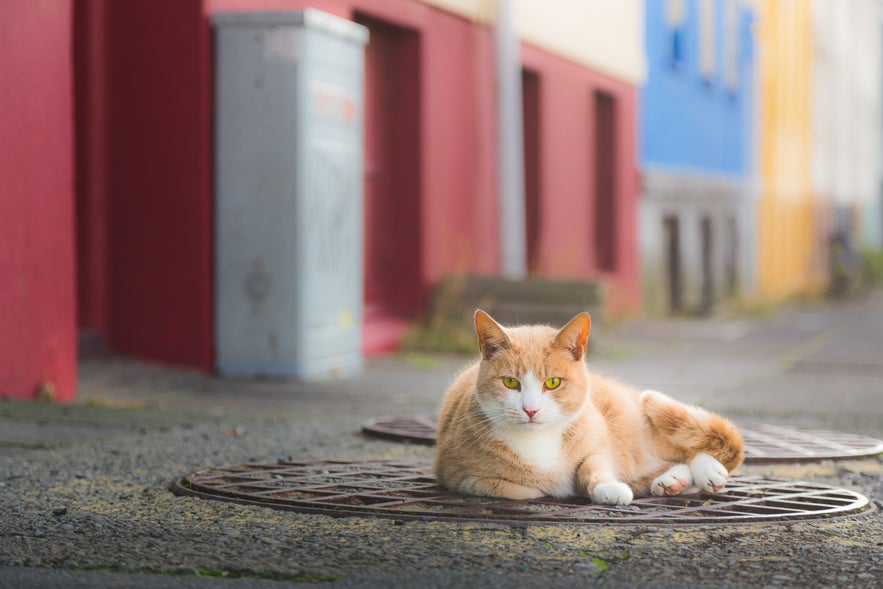
Mysterious, independent, and surprisingly social, cats have quietly become part of daily life in Iceland. They appear in everything from eerie Yule legends to lazy afternoons at cafes in downtown Reykjavik. These feline companions are more than just pets—they’re woven into the country’s culture and character.
Cats have lived alongside Icelanders for centuries, hunting pests, appearing in folktales, and curling up beside the fire. Today, cats in Iceland roam the streets with confidence, loved by both locals and visitors. Some have even achieved celebrity status, with adoring fans following their daily routines.
Why You Can Trust Our Content
Guide to Iceland is the most trusted travel platform in Iceland, helping millions of visitors each year. All our content is written and reviewed by local experts who are deeply familiar with Iceland. You can count on us for accurate, up-to-date, and trustworthy travel advice.
Whether you’re curious about Icelandic folklore or simply hoping to spot a fluffy local during one of the best tours in Reykjavik, this article has got you covered. It traces the pawprints of Iceland’s cats, how they arrived, the stories they inspired, and how they’ve become a charming feature of many city breaks in Reykjavik.
Fast Facts About Cats in Iceland
-
Icelandic cats have a deep cultural presence – They’ve transitioned from Viking-era pest controllers to beloved companions woven into everyday Icelandic life.
-
Folklore and myth highlight their mysterious charm – Stories like the Christmas Cat (Jolakotturinn) show how cats in Iceland are tied to seasonal legends and old beliefs.
-
There’s no official Icelandic cat breed – But over the centuries, cats in Iceland have developed unique traits suited to the island’s cold, remote environment.
-
Cats of Reykjavik roam freely – Neighborhoods like Thingholt, Vesturbaer, and areas near Hallgrimskirkja are known for feline sightings, often in cafes, shops, or on windowsills.
-
Kattakaffihusid is Iceland’s only cat cafe – Located in Reykjavik, it features adoptable cats from local shelters and reflects the city’s cat-friendly culture.
-
Reykjavik’s cats are treated with community care – Many cats in Iceland are microchipped, vaccinated, and looked after by entire streets rather than just individual households.
-
Famous local cats have fan followings – Felines like Baktus and Diego are well-known in Reykjavik and even featured in Facebook groups like “Spottadi kott.”
-
Icelandic cats thrive on freedom and mutual respect – Icelandic culture values cats’ independence, allowing them to come and go, making them a unique part of public life.
Origins and Arrival of Cats in Iceland
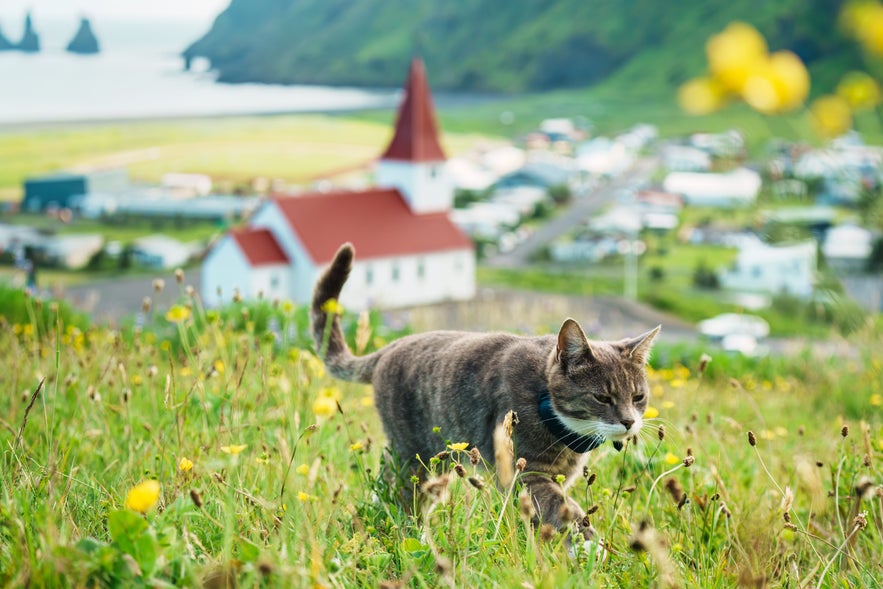 Cats likely arrived in Iceland with Norse settlers in the 9th century, sailing aboard Viking ships as trusted rat catchers. These seafaring felines helped protect vital food supplies during long journeys, and their usefulness continued once they reached land.
Cats likely arrived in Iceland with Norse settlers in the 9th century, sailing aboard Viking ships as trusted rat catchers. These seafaring felines helped protect vital food supplies during long journeys, and their usefulness continued once they reached land.
Meanwhile, in early Icelandic homes and outbuildings, cats guarded stored grains, dried fish, and meat. They were invaluable to survival in a harsh and often unpredictable environment.
Unlike dogs, which were more commonly tied to herding and protection, cats played a quieter role. They often stayed by the fire or walked around the barns, always keeping watch. As Iceland remained isolated for centuries, its cat population adapted to the island’s cold, windy, and solitary environment.
Through time, they became not just workers but companions, blending practicality with quiet affection.
Is There an Icelandic Breed of Cat?
There isn’t an officially recognized Icelandic cat breed, but locals often use the term “Icelandic cats” informally. Cats in Iceland have developed unique traits after centuries of living in a cold, remote place with few predators. With their dense, weather-resistant coats, bushy tails, and solid builds, these felines are built for long winters and chilly winds.
Most Icelandic cats are mixed breeds, the result of natural selection rather than human-controlled breeding. Their personalities often reflect their environment: calm, adaptable, independent, and surprisingly friendly for outdoor cats.
Many are even known to walk into shops, hop onto laps uninvited, or silently watch the world from the windowsills, without fuss.
While no formal breeding program exists, cats in Iceland commonly include Norwegian Forest cats, Bengals, British Shorthairs, Siamese, Ragdolls, and Himalayan or Siberian cats. These breeds, along with local mixes, contribute to the look and temperament people associate with Icelandic cats.
Over time, the Icelandic cat has become something of a cultural icon. Their appearance and behavior are so consistent that many residents and visitors easily recognize them. In a sense, Iceland cats aren’t defined by pedigree, but by the place itself, an unofficial breed born of island life.
Cats in Icelandic Culture
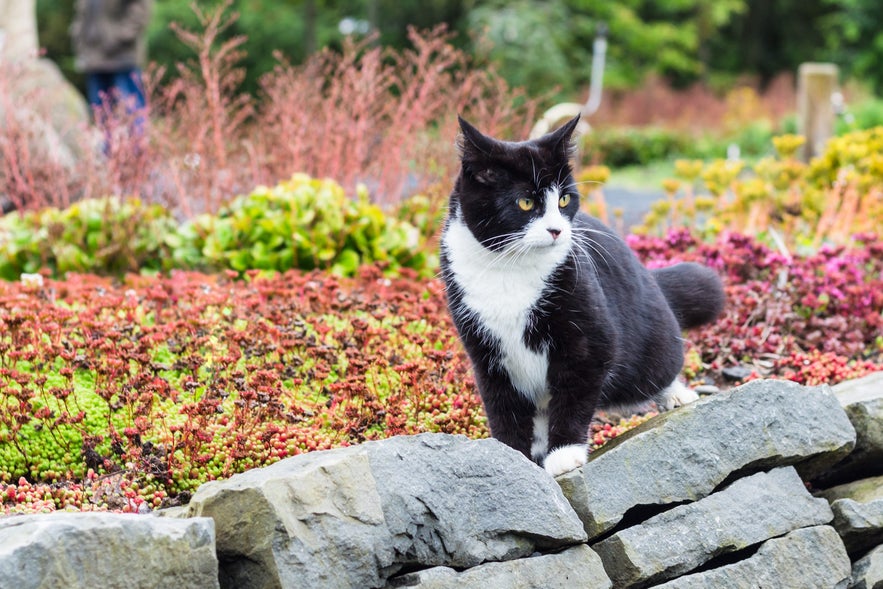 Cats have long held a quiet but curious place in Icelandic life. From folklore and old legends to street art and literature, they’re a part of the country’s cultural fabric.
Cats have long held a quiet but curious place in Icelandic life. From folklore and old legends to street art and literature, they’re a part of the country’s cultural fabric.
Cats in Icelandic Folklore and Mythology
Long before they curled up on sunny windowsills, cats stirred quiet curiosity in Icelandic folk beliefs. People believed their silent steps and sharp eyes gave them special powers. Some thought cats could sense spirits or predict the weather. A cat curling tightly before snowfall or acting restless on a clear night was thought to signal something unseen.
In older times, some believed cats moved between worlds, drifting between the ordinary and the otherworldly. They were often linked to witches and magic, especially during the long, dark months of winter. Unlike dogs, who were seen as loyal guardians, cats were viewed as something else: watchful, untamed, and hard to understand.
In the countryside, a cat choosing your home was a good sign, while a sudden departure could bring bad luck. Stories passed through generations told of cats arriving when needed, then vanishing just as mysteriously. Their independence and strange timing gave rise to superstitions that still echo in rural memory.
Cats may not appear much in Iceland's famous sagas or ancient poems. But in everyday stories and local superstitions, they are never far away. Calm, odd, and a little bit magical.
The Terrifying Christmas Cat – Jolakotturinn
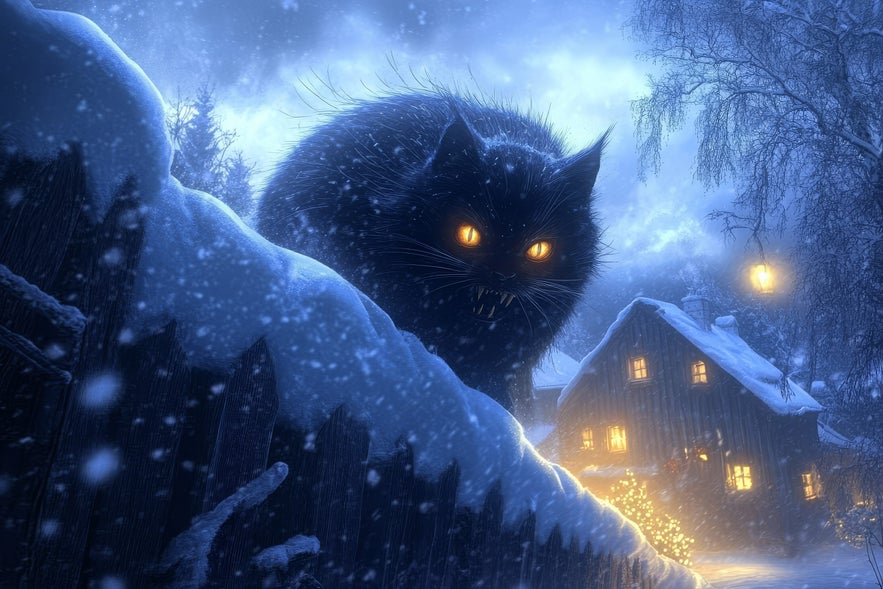 Among Iceland’s many holiday legends, none is quite as unsettling as Jolakotturinn, also known as the Christmas Cat. This enormous cat is said to wander the snowy countryside at Christmas, seeking out those who haven’t received new clothes. Anyone left without is believed to be in danger of being taken and eaten.
Among Iceland’s many holiday legends, none is quite as unsettling as Jolakotturinn, also known as the Christmas Cat. This enormous cat is said to wander the snowy countryside at Christmas, seeking out those who haven’t received new clothes. Anyone left without is believed to be in danger of being taken and eaten.
The Origins of Iceland’s Christmas Cat
The tale likely originated as a way to encourage hard work. In earlier times, wool production was essential, and families would spin, knit, and weave through the dark winter months. Those who finished their tasks were rewarded with a new garment before Christmas—those who didn’t risk the Yule Cat’s visit.
Jolakotturinn is often considered part of a fearsome holiday family. According to Icelandic folklore about the Yule Lads and their mother, Gryla, it belongs to Gryla, the child-eating ogress who lives in the mountains, and is the pet of her mischievous sons.
Where You Can See the Yule Cat Today
The Christmas Cat became even more well-known after Johannes úr Kötlum wrote a poem about it in 1932. His words helped turn the old warning into a lasting part of Iceland’s holiday traditions. Over time, Jolakotturinn began to appear in books, decorations, and festive displays.
Each December, a giant black sculpture of the Christmas Cat stands in central Reykjavik. Its glowing red eyes and sharp posture draw attention from visitors and locals alike, looking both eerie and oddly playful.
Cats in Icelandic Literature and Art
Cats don’t play big roles in the old Icelandic sagas, but they appear in Icelandic poetry, murals, and shop signage. Cats in Iceland are common in illustrations and children’s books, often depicted lounging in Reykjavik’s windows or streets.
Among stories about cats, the best-known example is Jolakotturinn, the Yule Cat, made famous by Johannes úr Kötlum’s 1932 poem, which transformed a dark piece of folklore into a holiday figure.
Since then, the Yule Cat has been featured in Christmas decorations, sculptures, and countless illustrations across Iceland. You can even see a 5-meter-tall sculpture of the Yule Cat in downtown Reykjavik during the holiday season.
Modern artists often feature cats in everyday scenes. You’ll see them curled up on windowsills, resting on radiators, or slipping through quiet streets. In Reykjavik, feline imagery adds warmth to the urban landscape, from the playful “101 Kettir” mural at Vesturgata 8 to the cat-and-mouse scene near Laugavegur and Grettisgata.
Around Thingholtsstraeti, a painted door reveals a cat peeking out, blending seamlessly into the street architecture. You’ll even spot cat-themed shop signs and displays in areas like Laugavegur and Skolavordustigur, where local cafes and boutiques celebrate Reykjavík’s quiet obsession with cats.
Though they may not be heroes in epic tales, cats have become steady companions in Iceland’s stories and art. Their presence is quiet but lasting, just like the animals themselves.
Cats of Reykjavik Today
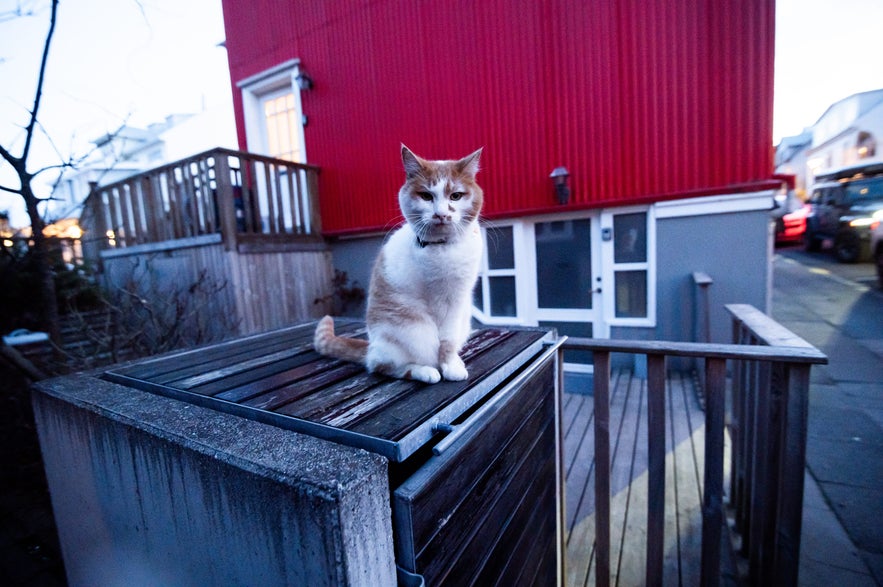 Cats are everywhere in Reykjavik and locals often call them “kisa,” a warm, familiar word for “kitty” in Icelandic. You’ll see cats sitting on doorsteps, napping in shop entrances, or perched on windowsills watching the street. Some wander calmly between cafés or stroll across the road like they own it.
Cats are everywhere in Reykjavik and locals often call them “kisa,” a warm, familiar word for “kitty” in Icelandic. You’ll see cats sitting on doorsteps, napping in shop entrances, or perched on windowsills watching the street. Some wander calmly between cafés or stroll across the road like they own it.
The cats of Reykjavik are more than just pets—they’re part of the neighborhood. Many are known by name, welcomed by shopkeepers, and treated like locals. A cat may belong to one household, but the whole street looks after it.
Many cats in Reykjavik follow their own routines. Visitors are often surprised by how calm and confident these cats are. Some will accept a gentle scratch or pose for a photo, while others may completely ignore you. Whether friendly or aloof, the cats of Reykjavik give the city a sense of character.
Why Cats Thrive in Downtown Reykjavik?
Reykjavik is one of the few capital cities where cats still roam freely, and this is not by chance. The city has a gentle pace, calm streets, and neighborhoods that feel more like quiet villages than busy cities. Traffic is light, especially in residential areas, so it’s safer for animals to wander. Cats in Iceland, especially in Reykjavik, feel at home in this kind of environment.
The local culture also helps explain this. Icelanders tend to see cats as independent souls. While dogs are more closely supervised, cats are often free to come and go. Many homes leave windows or doors slightly open during warmer months, allowing cats to return when they choose.
In some parts of the city, neighbors share responsibility for a cat. They feed them, check on them, and enjoy their presence. Small shelters are sometimes built during winter to provide cats a warm place to rest. Food and water bowls appear on doorsteps or tucked beside garden walls.
Most cats in Reykjavik are not strays—they’re microchipped, vaccinated, and regularly checked by their owners. Some spend more time outdoors than indoors. A cat might live with a family but also feel at home in a nearby cafe or courtyard. This mix of freedom and care is part of daily life in Reykjavik. And in a city that values calm and respect, cats thrive.
- Join a small-group cat-themed walking tour in Reykjavik with snacks with your fellow cat lovers
- Immerse yourself in a private 2-hour cat-themed walking tour in Central Reykjavik and discover the city’s feline allure
Famous Cats of Reykjavik
Some cats in Reykjavik are more than just familiar faces—they are also local celebrities. People know their names, their favorite spots, and even their personalities. These cats have carved out little kingdoms for themselves, one street corner or storefront at a time.
One of the most famous is Baktus, who often spends his days near Austurstræti. You’ll often see him lying on shop mats or lounging in doorways. People often think he visits a nearby store, but Baktus actually lives at Gyllti Kötturinn (The Golden Cat), a vintage boutique on Austurstræti. He’s friendly but selective, and that just adds to his charm.
In Skeifan, Diego has claimed an entire block as his territory. He patrols the area like a mayor, slipping in and out of offices and cafés. He’s such a regular sight that people check on him every day. If he’s not outside, someone is probably already wondering where he went.
Other cats in Iceland have gained smaller followings, with neighbors sharing stories and photos online. Some have Instagram accounts or Facebook fan pages run by local admirers. There’s also an Icelandic Facebook group called Spottadi kott (“Spotted a Cat”), where members post photos of cats they see around town.
The cats of Reykjavik have their own personality. Some are friendly and bold, while others are shy and mysterious. But they all have one thing in common—they’re part of the city’s daily life. Cats bring a quiet kind of joy that never asks for attention but always gets it.
Where To Spot Cats in Reykjavik
Looking to meet a Reykjavik cat? Start with neighborhoods like Thingholt, Vesturbaer, and the quiet streets near Hallgrimskirkja Church. These areas are calm, walkable, and full of cats relaxing on steps or watching from windows.
If you'd like to spend time with cats indoors, visit Kattakaffihusid, Iceland's first and only cat cafe, located at Bergstaðastræti 10a. The cafe is open daily from 10:00 AM to 5:00 PM. Sip coffee and enjoy vegan treats while interacting with resident cats, all of whom are available for adoption.
These cats are typically surrendered by local owners who can no longer care for them. Before joining the cafe, each cat is neutered and vaccinated. Kattakaffihusid maintains a small group of five to seven cats at a time to ensure their well-being.
Even outside the cafe, Reykjavik often feels like a giant cat cafe. Walk slowly, pay attention, and you’re likely to spot one. In Reykjavik, cats are everywhere—you just need to know where to look.
Tips To Enjoy Reykjavik's Cat Culture
Reykjavik’s cats are part of the city’s rhythm. They’re independent, curious, and often found lounging near cafes or strolling through parks. If you’re hoping to meet a few during your visit, keep these simple tips in mind to enjoy their company respectfully.
-
Don’t feed the cats. Feeding them may disrupt their routines or encourage begging behavior.
-
Be gentle and respectful. Let the cat approach you. Some enjoy attention, others don’t.
-
Don’t try to pick the cats up. Even friendly cats prefer space. Pet them only if they seem comfortable, or if the locals taking care of them tell you so.
-
Join a Reykjavik cat walking tour. A guided cat walk tour introduces you to the city’s feline celebrities, stories, and daily hangouts.
-
Chat with the locals. Don’t hesitate to ask shopkeepers or locals about a cat’s name or their habits.
-
Look out for cats near popular spots. Check them out near Hallgrimskirkja and Austurvollur Square for interesting cat photos.
-
Visit Kattakaffihusid (The Cat Cafe): Relax with coffee and meet adoptable cats from local shelters in this cozy café near Hverfisgata.
Frequently Asked Questions About the Cats in Iceland
Curious about the cats you see strolling through Reykjavik’s streets? From petting etiquette to ownership laws and travel rules, here are answers to some of the most common questions about Iceland’s feline residents.
Is it safe to pet cats in Reykjavik?
Yes, it’s generally safe to pet cats in Reykjavik. Most cats roaming in the city belong to nearby homes and are used to human interaction. They often relax in parks, near cafes, and along residential streets. Many are friendly, but always let the cat come to you first, as some may be shy or unfamiliar with strangers.
Are there any rules or laws about outdoor cats in Iceland?
Yes, there are laws about outdoor Icelandic cats, and they vary by location. In Reykjavik, cats can roam freely and must be microchipped and registered. In Akureyri, stricter rules apply, including a curfew that keeps cats indoors from midnight to 7 AM to protect local wildlife. While there’s no national ban, travelers should check local regulations.
Can foreign travelers adopt cats from Iceland?
Yes, international adoptions are possible but require preparation. Rescues like Kisukot in Akureyri occasionally work with travelers, depending on their ability to meet housing and transport requirements. Adopters must also comply with both Icelandic export rules and the import laws of their home country.
What is the process for bringing a cat into or out of Iceland?
Bringing a cat into or out of Iceland requires an import permit from MAST, which must be secured at least 30 days in advance. Like all cats in Iceland, incoming cats must be microchipped, vaccinated against rabies, treated for parasites, and undergo blood tests. All cats must undergo a 14-day quarantine upon arrival.
Travel carriers must meet IATA standards, and airlines may have additional rules. Exporting a cat also involves health certifications and pre-approved travel plans.
What are Reykjavik’s rules for cat ownership?
Cat ownership in Reykjavik requires registration and microchipping through the city. Cats must wear collars with contact information, and outdoor tomcats must be neutered by six months old.
During bird nesting season, cats must either wear bells or stay indoors for part of the day. Annual deworming is also mandatory to prevent tapeworm infections.
Do stray or feral cats exist in Reykjavik?
Stray or feral cats are not common in Reykjavik. Thanks to strict registration, neutering programs, and community care, most cats seen outdoors in the city are pets or managed community cats.
The Enduring Bond with Cats in Iceland
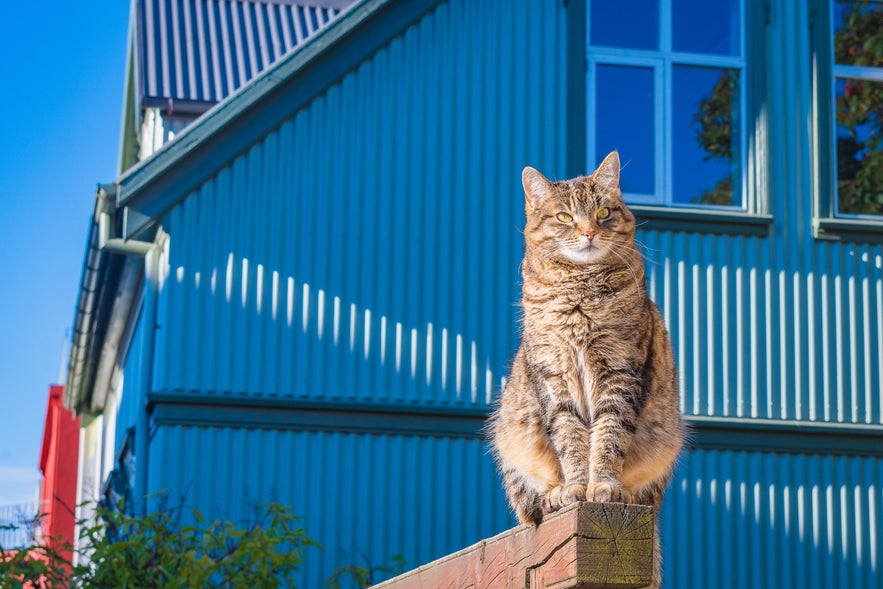 From mythical creatures to cuddly city pets, Icelandic cats have a long and special story. They once guarded food stores, appeared in old legends, and today, they bring delight to everyday life in Reykjavik.
From mythical creatures to cuddly city pets, Icelandic cats have a long and special story. They once guarded food stores, appeared in old legends, and today, they bring delight to everyday life in Reykjavik.
Whether you're drawn by history, folklore, or the chance of a furry head bump on a chilly street, Iceland's cats are waiting. Just remember: they’ll come to you when they’re ready.
To see the cats in Iceland is to glimpse something about the country itself. Life is calm, the streets are quiet, and there’s space for living things to move freely. People do not rush them or claim them, they are respected as they are.
So, if you visit Reykjavik, slow down and explore the streets. You might meet a cat who knows the neighborhood better than you ever will. And in that moment, you’ll understand why Iceland is a place where cats truly belong. Discover even more local highlights with the Top 15 Things To Do in Reykjavik
We hope this guide gives you a deeper appreciation of cats in Iceland and helps you spot a few whiskered locals during your time in Reykjavik. Whether you’re a lifelong cat lover or just curious about their role in Icelandic life, let us know if you have questions. You can also share your favorite cat sightings in the comments below!


